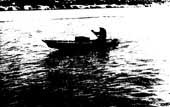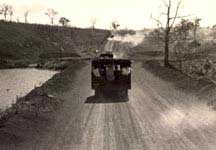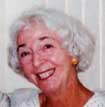by Bobbie Bergesen
A frequent contributor to these pages, the author retired to Florida after a long career as a Foreign Service spouse. She has written extensively on various of her experiences abroad and is particularly adept at catching the feeling and mood of a post. —Ed.
The sun was hot that early afternoon in 1963 as my husband and I drove out from Phnom Penh on the Saigon road. A career Foreign Service officer, Alf had recently taken up his post as head of the political section in the American embassy in the Cambodian capital. Although we had only arrived six weeks earlier, we had enjoyed getting acquainted with the charming city with its French colonial overtones such as the popular Cercle Sportif, and taking sightseeing drives along the excellent roads in the peaceful Southeast Asian countryside.The road we took that afternoon was familiar because we had already driven it on a sightseeing tour on our first weekend. At that time, the watery landscape it ran through impressed us vividly: the entire countryside seemed inundated. Wooden houses, the local basha huts, were raised above water by stilts; treetops stood out in full leaf although the trunks were wholly submerged; gleaming rice paddies reflected light like mirrors; and, in every direction, we saw local men fishing from boats, in the paddies, and even from the porches of their houses.

This time the water level looked lower. Tree trunks were partly exposed and mud filled many paddies. Mud flats surrounded many houses. As it was supposed to, the three months’ rainy season brought by the southwest monsoon was ending. At least, so we understood.
With our two children, Alf and I were driving to a Buddhist festival, Bon Kathen, which was to take place at the village of Churi Dang, some forty kilometers southeast of the capital. Although it was the first we were invited to attend, similar ceremonies were held throughout Cambodia. They celebrated the end of the monks’ period of isolation in the monasteries, or wats, during the rainy season. At these yearly festivals, the monks were given clothing and other necessities, and general festivities followed the religious ceremonies.
American guests at the Churi Dang festival were to meet at Martin’s house. A blond young American, he was an International Voluntary Services (IVS) technician who had lived and worked in the village a year. By the time we arrived, nineteen gifts, previously prepared by the village people for their monks, had already been presented and were neatly laid out in the wat. The gifts, wrapped in brightly colored cellophane, included the saffron yellow cloth worn by Buddhist monks, a big package of incense sticks, sugar, tea, ceremonial candles, and cigarettes. We had already noticed most Cambodians were heavy smokers.
Except for the monks, who watched from the pagoda, everyone in the village seemed to be gathered around a volleyball court where a group of Americans, mostly IVS teachers, were to play the teachers of Churi Dang. Along with other late arrivals, we were shown to a platform where chairs were set up overlooking the court. A temporary roof of translucent, flexible plastic sheets stretched over a bamboo framework entirely covered this platform. Behind it, at a slightly lower level, was another platform covered by a similar roof.
Soon after we sat down, the volleyball game began. By the third set, enthusiasm ran high. Noisy cheering marked points scored by both sides. But for some time, the sky had been darkening, and a light rain began to fall. Under our plastic roof, an occasional umbrella bloomed as rain began to blow through the unprotected sides of the platform. When a real downpour started, the game abruptly ended, and people took shelter in or under the wat (which was on stilts), and on the platform. Rain drummed on our roof. Several Americans hurriedly brought up their cars, loaded in their families and drove off. Thunder crashed as the rest of us huddled in a corner of the platform.
Other guests had previously gone to the wat porch to line up for an elephant ride, one of the main attractions. Now the elephant was pressing his side against the wat. His head was bent as though he was trying to hide it under the porch, and his pink-sponed gray ears hung forlornly while rain poured down his glistening flanks.
In my corner, everyone unsuccessfully tried to stay dry. At the first raindrops, I tied a small square of silk chiffon over my head, assuming this would see me through. Rain began to fall so heavily, however, that our roof began to sag ominously in places. Weighty pockets of water hung visibly poised over our heads.

Quickly noting these signs of impending calamity, villagers and guests alike clambered on the platform chairs. They pushed at the plastic overhead, they poked with their hands, with planks and with bamboo staffs, trying to roll the water to the outer edges of the plastic, where it could fall in cascades over the platform sides. “It’s like catching jellyfish,” shouted one worker as he vainly manipulated the plastic. Our ten-year old son, Chris, was soon drenched as he dashed about, efflciently moving chairs out of one stream of water into another. Splashing back to my platform with progress reports, he said to a soaking fellow laborer, “Well, you can’t win ’em all!”
Inevitably, nature drew ahead. Holes appeared unexpectedly in our roof, through which torrents gushed, dousing hapless victims. Loud crack-ing noises burst through the general noise level as poles in the bamboo framework gave way. As the roof sagged further, men held the remaining poles in place like Atlas shouldering the sky. It was like being in a storm at sea, except that instead of staring down at tossing waves, we gazed anxiously upward at the heaving roof.
Swaying slightly, I was standing bemused when Martin sloshed over and said, “We’d better get over to the wat. It’s going to get worse and the roof isn’t going to last much longer.” Suddenly, I realized that we were among a very few still on board. The roof was flapping like a luffmg sail. “Can you take off your shoes?” he asked.
“Yes, indeed,” I said, and leaning down, I quickly took off my sandals. With his help, I jumped off the platform into deep mud and ran squashing over to the wat, twenty feet away. Feeling my way up its stairs, hair and shoulders streaming water, I stood confused a moment on the porch, staring through the doorway at the quiet scene inside. Sitting circumspectly on woven mats scattered on the planked fiooring of the large open room were groups of families chatting calmly. Clumps of children stood watching the few Americans talking amiably among themselves. Candles gleamed peaceably among the statues of Buddha, and heavy paper decorations hung unmoving from the rafters. Two American boys had devised a game; they poked their fingers down narrow cracks in the floor, and now and then a finger poked back at them from below. Squealing and laughter resulted, especially if the finger happened to poke a sitting bystander. It was nearing five in the afternoon. Martin and various local officials stood by the wat doorway smoking. News filtered through the crowd. No more volleyball; the court was flooded. Would the rest of the program be held in the wat? A microphone was brought in. Four damp IVS teachers, the girls’ wet hair slickly combed, accompanied by a guitar, sang folk songs. “Twist!” a Cambodian shouted, clapping his hands and laughing, but his request was ignored, possibly because there was no room.

Finally, the organizers reached a decision. The village chief, dignified yet friendly, dressed in a blue western suit and muddy black shoes, first spoke into the microphone. Then in English, Martin announced dinner would be served in the wat, after which the entertainment would resume outside.
We were shown to one side of the room where flatware, plates, and bowls of food were laid out on the floor mats. Settling ourselves on the mats, we served the food to each other. One large bowl contained cooked rice, each grain separate and whole. Over the rice in our own bowls, we ladled a curry of green beans, chicken livers, yams, fish, and other things, all in a spicy looking sauce. Soy and a thin hot chili sauce were in separate dishes, to be added to taste. There was a platter of small pieces of fried chicken. Transparent noodles cooked with egg and shrimp and a dish of bean sprouts were also served. The final platter held broiled bite-size pieces of beef, with raw onion slices and lettuce leaves on the side. Bananas and soft drinks in bottles with straws rounded out the menu. Although everyone feasted, we ate more lightly than our Cambodian neighbors, who quickly emptied their rice bowls.
After dinner, we moved back to the center of the wat while the next round of people were fed. A villager clutched the microphone, loudly haranguing an indifferent audience. People began to move outside again. Volunteers began to repair the platform, put back the roofs, and set things up for the dancing and singing to follow. Chris, still soaked through, rushed out and went to work.
The rain had definitely slackened. Wandering outside, I sat under the restored roof of the lower platform to watch the preparations. The higher platform was now to be the stage. The chairs had been removed and the floor swept clean of chunks of chewed sugarcane and windblown debris. Several men worked on the footlights. Long white fluorescent tubes illuminated the stage; they flicked on and off with little references to activities on stage.
I watched workers grope through the leaf-decorated exterior of the stage to find necessary wires. Everything was still sopping. Two or three loud reports and small puffs of smoke indicated the would-be electricians’ difficulties, happily none of them serious. We were invited back to the wat to watch the monks at evening prayer, but I did not go. After prayers, the monks retired to their living quarters in a house next to the wat while the audience returned outside. The number of spectators had grown. There now seemed to be an enormous crowd, although it was hard to judge its size through the shadows of the wet night. People pressed closely about the stage, clustered up and down the wat steps, and murmured all around and behind us.

About eight o’clock, the entertainment began with a bang. A couple of firework explosions and a wild yell or two announced the Chhayam (“joyful music”) dance, which the villagers had rehearsed all week. While the dancers performed energetically, snakeskin drums were rhythmically beaten and gongs struck repeatedly. Square dancing to taped music by the IVS students followed, and the program continued with alternate presentations by both nationalities. It included comedy sketches by village youths whose pointed sallies were received uproariously by the audience. Anticipation quickened toward the finale. It was to be a special dance, but one about which none of the Americans seemed to know much. The dancers took their places on stage in darkness. When the lights came on, they were seen to be made up in black-face, wearing necklaces of big pink local snail shells and dressed in short skirts of dried palm leaves. One performer, a comedian earlier, sat directly facing us, grimacing, blowing out his cheeks, rolling his eyes and jerking his head sideways and back. Behind him, the dancers used hand movements reminiscem of Hawaiian hula gestures, while the Western-sounding music carried overtones of “Babalu.”
Was it an authentic folk dance, a parody, or both? It was supposed to be a Cambodian-Laotian dance of the mountain people, the “negritos,” from the northern tribal regions between the two countries. No one we asked in the haste of getting back to town with our drowsy children could explain it further. Back home about midnight, we showered, removing tr aces of village mud. All four of us agreed that we had enjoyed our first Bon Kathen. Although the rain had cut down the number of American guests, the weather certainly failed to dampen the villagers’enthusiasm. Festivities were to continue the next day at Churi Dang.
The day dawned sunny and beautiful, but we didn’t drive back.![]()
Photos by Alf Bergesen

The author accompanied her late husband to a number of assignments abroad in the U. S. Foreign Service. She has written for American Diplomacy several accounts of her expereiences as a Foreign Service spouse.
